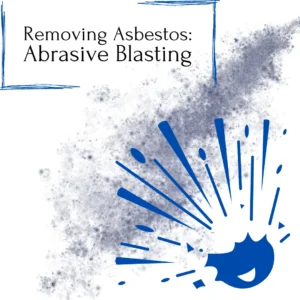Date: July 12, 2024
Edited and Reviewed by Dave Halpern
Key takeaways: Abrasive blasting combines the use of an abrasive material with water flow to mitigate dust kick-up. This technique is useful for removing products that contain asbestos, like paint, sealant, or another substrate, as abrasive blasting preserves structural integrity. The U.S. Army Corps of Engineers utilized abrasive blasting on several buildings that had asbestos (and lead)-containing paint, and were able to safely demolish the buildings while mitigating asbestos exposure.

What is abrasive blasting? How does it mitigate asbestos exposure?
Abrasive blasting is a technique that has been utilized by the construction and demolition sectors for years. More technically, it’s called “water-injected abrasive blasting,” as it combines the use of an abrasive material with water. The abrasive material—usually coal slag or silica sand—initially removes the target layer (which contains asbestos), while the water injected at the site of abrasion mitigates the dust that would usually kick up. This means that the asbestos is successfully abated; at the same time, contractors and demolition specialists are protected in ways they usually wouldn’t be. Although asbestos poses minimal risks when it’s contained—in this case, in another material like paint or sealant—it poses serious risks when it’s mechanically disturbed. When disturbed, asbestos fibers can become airborne; airborne fibers are easily digested and can cause asbestosis, lung cancer, or mesothelioma.
Even though personal protective equipment and high hazard vacuums largely protect people that work with asbestos removal, these methods aren’t foolproof. In countries that have banned asbestos decades before the U.S. did, the instance of mesothelioma is highest among people that directly work with asbestos abatement, treatment, or removal. These statistics mean that personal protective wear isn’t as effective (or as safe) as it should be, hence the need for more drastic protective and preventive efforts. Banning asbestos isn’t enough to protect those that have to directly engage with asbestos for work.
The U.S. Army Corps of Engineers utilized abrasive blasting at a site of demolition in Colorado. There were a host of concrete buildings that needed to be destroyed, but the paint (and other construction materials) contained both lead and asbestos. The effort was largely successful, as the final structures were essentially asbestos-free and were safe for demolition. Besides abrasive blasting, the endeavor utilized extensive ventilation to mitigate asbestos exposure—ventilation is already commonplace for abatement projects. The Corps were able to safely demolish the structures without releasing asbestos or lead into the surrounding communities and natural resources.
Could abrasive blasting be used more widely?
The Army Corps project was completed in 2003, so it’s been over two decades since abrasive blasting was proven a successful alternative to traditional abatement methods. There are a few challenges associated with abrasive blasting that might prevent it from becoming a more widely available alternative, though. For one, it doesn’t address larger asbestos-contaminated structures/objects, like insulation, asbestos cement pipes, etc. Plus, it requires advanced equipment and a team of skilled experts in order to be successful. Despite challenges, though, it remains a largely untapped resource. Most asbestos abatement specialists still rely on traditional safety precautions, although they could greatly benefit from abrasive blasting.
As the U.S. begins to replace impaired asbestos infrastructure, abrasive blasting could become a feasible option for a.) safety; b.) accessibility; and c.) reducing the instance of mesothelioma.
If you or a loved one has been diagnosed with mesothelioma, please call The Halpern Law Firm at (800)-505-6000. We are here to help you navigate the legal process of filing a claim to receive compensation for your cancer diagnosis. We help mesothelioma victims and their families in Pennsylvania.
Sources:
https://apps.dtic.mil/sti/tr/pdf/ADA429620.pdf
https://www.randrmagonline.com/articles/87879-vapor-abrasive-blasting-handles-lead-abatement
https://www.alleghenycounty.us/Services/Health-Department/Air-Quality/Asbestos-and-Abrasive-Blasting
